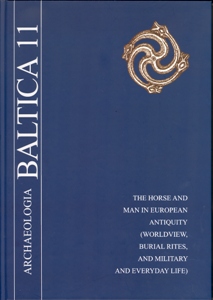Volume 11 (2009): The Horse and Man in European Antiquity (Worldview, Burial Rites, and Military and Everyday Life), August 2009

Order by:
Pub. online: 30 Aug 2009
Type: Introduction
 Open Access
Open Access
Journal:
Archaeologia Baltica
Volume 11 (2009): The Horse and Man in European Antiquity (Worldview, Burial Rites, and Military and Everyday Life), pp. 8–11
Pub. online: 30 Aug 2009
Type: Article
 Open Access
Open Access
Journal:
Archaeologia Baltica
Volume 11 (2009): The Horse and Man in European Antiquity (Worldview, Burial Rites, and Military and Everyday Life), pp. 14–21
Abstract
Pub. online: 30 Aug 2009
Type: Article
 Open Access
Open Access
Journal:
Archaeologia Baltica
Volume 11 (2009): The Horse and Man in European Antiquity (Worldview, Burial Rites, and Military and Everyday Life), pp. 22–31
Abstract
Pub. online: 30 Aug 2009
Type: Article
 Open Access
Open Access
Journal:
Archaeologia Baltica
Volume 11 (2009): The Horse and Man in European Antiquity (Worldview, Burial Rites, and Military and Everyday Life), pp. 32–36
Abstract
Pub. online: 30 Aug 2009
Type: Article
 Open Access
Open Access
Journal:
Archaeologia Baltica
Volume 11 (2009): The Horse and Man in European Antiquity (Worldview, Burial Rites, and Military and Everyday Life), pp. 37–47
Abstract
Pub. online: 30 Aug 2009
Type: Article
 Open Access
Open Access
Journal:
Archaeologia Baltica
Volume 11 (2009): The Horse and Man in European Antiquity (Worldview, Burial Rites, and Military and Everyday Life), pp. 50–55
Abstract
Pub. online: 30 Aug 2009
Type: Article
 Open Access
Open Access
Journal:
Archaeologia Baltica
Volume 11 (2009): The Horse and Man in European Antiquity (Worldview, Burial Rites, and Military and Everyday Life), pp. 56–88
Abstract
Pub. online: 30 Aug 2009
Type: Article
 Open Access
Open Access
Journal:
Archaeologia Baltica
Volume 11 (2009): The Horse and Man in European Antiquity (Worldview, Burial Rites, and Military and Everyday Life), pp. 92–114
Abstract
Pub. online: 30 Aug 2009
Type: Article
 Open Access
Open Access
Journal:
Archaeologia Baltica
Volume 11 (2009): The Horse and Man in European Antiquity (Worldview, Burial Rites, and Military and Everyday Life), pp. 115–129
Abstract
Pub. online: 30 Aug 2009
Type: Article
 Open Access
Open Access
Journal:
Archaeologia Baltica
Volume 11 (2009): The Horse and Man in European Antiquity (Worldview, Burial Rites, and Military and Everyday Life), pp. 130–148
Abstract